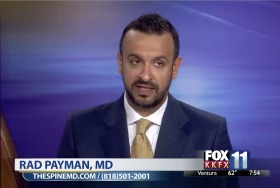Dr. Payman will show which types of non-surgical therapies are proving to be effective for many patients. “When surgery is required, minimally invasive procedures can dramatically reduce downtime for recovery. In many cases patients can gain improved range of motion. Micro-laminectomy, disc replacement and spinal fusion are among the surgical procedures which are available. With minimally invasive procedures there is less disturbance to the body. Patients heal faster and they usually recover more fully,” says Dr. Payman.
 “One of the common causes of lower back pain is lumbar spinal stenosis, which is the compression of spinal nerves caused by narrowing of the spinal canal. Spinal stenosis can also affect the spine in the neck region," says Dr. Payman. "Symptoms include back pain, burning or an aching pain in the buttocks that radiates to the legs (sciatica) and weakness in the legs. Treatment may include non-surgical options such as physical therapy and medication. If these treatments don’t bring relief, surgery is the next consideration. The two main surgical procedures to treat lumbar spinal stenosis are laminectomy and spinal fusion. A micro-laminectomy may relieve the pain for patients with symptomatic, painful lumbar spinal stenosis with less downtime than a traditional laminectomy.”
“One of the common causes of lower back pain is lumbar spinal stenosis, which is the compression of spinal nerves caused by narrowing of the spinal canal. Spinal stenosis can also affect the spine in the neck region," says Dr. Payman. "Symptoms include back pain, burning or an aching pain in the buttocks that radiates to the legs (sciatica) and weakness in the legs. Treatment may include non-surgical options such as physical therapy and medication. If these treatments don’t bring relief, surgery is the next consideration. The two main surgical procedures to treat lumbar spinal stenosis are laminectomy and spinal fusion. A micro-laminectomy may relieve the pain for patients with symptomatic, painful lumbar spinal stenosis with less downtime than a traditional laminectomy.”
Dr. Payman will also discuss artificial disc replacement and spinal fusion and he will show how people can help take steps to help avoid back or neck pain when traveling or sitting for long periods.
For more information on lower back pain, neck pain and the latest non-surgical and minimally invasive treatments visit http://www.TheSpineMD.com or call 818.501.2001.
Article provided by PRWeb - Online Visibility from Focus